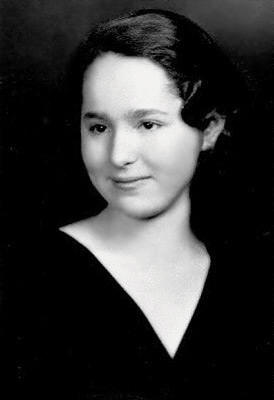
Clara Immerwahr was brilliant . . . with bad taste in men. But Clara’s bad choice translated into a very tragic story.
Clara was the youngest of four children in a comfortable, cultured family. They spent most of the year on the family farm and winters in Breslau with Clara’s grandmother. She and her sisters were tutored privately and attended a girls’ school located in her grandmother’s home.
Although her sisters wanted to marry, Clara bristled at the mention of the “prospective sphere of women’s occupations.” She was interested in natural science and had a desire to be financially independent. When her mother died in 1890, her father turned operation of the farm over to Clara’s sister Elli and her husband and moved with Clara to Breslau. There she attended a teacher’s seminary where the principal recognized her abilities and gave her a copy of Conversations on Chemistry by Jane Marcet.
After completing her teacher training, Clara worked as a governess, but she still had a desire for more training in science, specifically chemistry. Her father’s university degree was in chemistry and he was delighted to support and help her.
By 1896, women were allowed to attend university lectures at Breslau as visitors, but Clara continued to fight for permission to take the qualifying exam for admittance into the doctoral program. In 1898, she became the first woman to pass the exam. Then on December 12, 1900, she achieved another first when she graduated magna cum laude with a Ph.D. in chemistry, becoming the first woman to receive this degree from a German university.
In spite of her achievement, it was still a boys club. Clara was able to work as an assistant to Richard Abegg, her doctoral advisor, do some research and give lectures to women’s organizations and schools, but she was limited because of her gender.
Around this time, Clara became reacquainted with Fritz Haber. Fritz had proposed to her several years before, but she had turned him down. At the time she was focused on her own studies. When they met again in the spring of 1901, the flame was rekindled and they married in August of that year.
Haber had developed quite a reputation. He was respected for his work in chemistry and had developed a method to convert nitrogen in the atmosphere into compounds that could be used in fertilizer. This method revolutionized agriculture and he was awarded the Nobel Prize for Chemistry in 1918.

Fritz was a professor at the Technological University in Karlsruhe. He was ambitious and frequently brought home guests unannounced. Clara thought at first that she would be able to continue her research, but the demands of homemaking and soon motherhood proved too much. However, she did collaborate with Fritz on his work and on a textbook about thermodynamics. He dedicated the book to Clara with thanks for “quiet collaboration.”
In spite of this, he had little respect for Clara’s work. As a workaholic, he also had little time for Clara and their son, Hermann. He traveled frequently and had affairs with other women.
Fritz Haber’s star continued to rise and in 1911, he was appointed head of the Kaiser Wilhelm Institute in Berlin. This honor came with a position as professor at the University of Berlin and membership in the Prussian Academy of Science. In spite of these honors, he may have felt some pressure to prove his patriotism.
Both Fritz and Clara were Jewish and had converted to Christianity in 1893 and 1897, respectively. Antisemitism was prevalent, including a ban preventing Jews from being officers in the army, and even very talented people of Jewish birth came under suspicion.
When the war broke out in 1914, Fritz volunteered his services and soon came up with a horrifying idea. He concentrated his work on poison gas and suggested that chlorine gas could be released to drift over the enemy’s position, disabling them without bombardment.
Clara was appalled and on more than one occasion begged him to stop his research on chemical warfare. She opposed him openly and he accused her in public of treasonous statements. When Clara received her Ph.D., she took an oath to “never in speech or writing to teach anything that is contrary to my beliefs. To pursue truth and to advance the dignity of science to the heights which it deserves.” She believed that Fritz had perverted the ideals of science.
There were also German commanders who thought the use of poisonous gas was “unchivalrous” or “repulsive,” but might be necessary if it meant victory. The first gas attack occurred on April 22, 1915 at Ypres in Belgium. After waiting for the winds to be just right, 168 tons of chlorine gas were released and drifted over the Allied troops, killing over half of them within minutes. A second attack was launched two days later.
Fritz was promoted to captain and returned to Berlin to a party in his honor on May 2, the day before he was to go to the Eastern front to oversee similar attacks. Early in the morning after the party, Clara took her husband’s revolver into the garden and shot herself. Her son heard the shot and she died in his arms. The next day Fritz went to the Russian front leaving 13-year old Hermann to deal with his mother’s suicide alone.
Since the 1970s, Clara’s life has received more attention. She is seen as an example of protest against the misuse of science. The most prestigious award given by the German section of the International Physicians for the Prevention of Nuclear War is called the Clara Immerwahr award; the University of Dortmund has a mentoring project for women named for her; and Clara is the subject of Tony Harrison’s play Square Rounds. It may have taken a little time, but she hasn’t been forgotten.
Resources
Jewish Women’s Archive: Clara Immerwahr
Smithsonian Magazine: Past Imperfect: Fritz Haber’s Experiments in Life and Death











